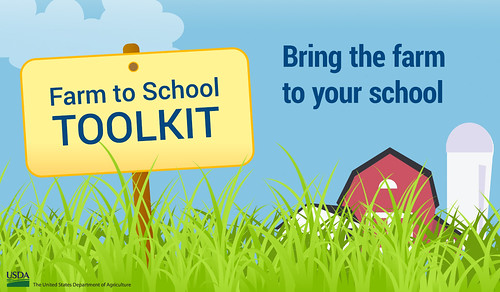
Healthy habits are taking root in our nation’s schools. Thanks to an important commitment made possible by the Healthy, Hunger-Free Kids Act of 2010, more of our nation’s kids are being exposed to lessons about healthy eating and learning where their food comes from. Established as part of that legislation, USDA’s Farm to School Program plays a vital role in improving health outcomes for our schoolchildren.
This October, during National Farm to School Month, it’s important to acknowledge farm to school programs’ contributions to fostering a healthier next generation. These programs support the work of parents, teachers, school nutrition professionals, and communities to make sure the healthy choice is the easy choice for America’s children.
Farm to school brings local or regionally produced foods into school cafeterias; hands-on learning activities such as school gardening, farm visits, and culinary classes; and the integration of food-related education into the classroom curriculum. To help schools create or strengthen an existing program, we recently launched the Farm to School Planning Toolkit to provide tips and examples, insights, and research-based resources. The accessible guide enables schools, school districts and community partners to map out and build on their program’s vision.
In USDA’s vision, school cafeterias championing U.S. agriculture and promoting local foods are the norm, not the exception. Local foods span the school meal tray and include everything from the salad bar and fresh fruit and vegetable servings to the wheat in the pizza crust, beans in the chili, rice in the stir fry, turkey in the sandwiches, and cheese in the quesadillas.
Research shows that children in schools with farm to school programs eat more fruits and vegetables and are more willing to try new, healthy foods—positive steps in the right direction in the battle against childhood obesity. By instilling smarter, more nutritious behaviors, we make it easier for our future leaders to grow, thrive and reach their highest potential.
USDA understands that schools have unique circumstances and needs and have constructed a roadmap to ensure long-term success for any type of farm to school program. We’re proud to say that farm to school programs now exist in every state and in every type of district – large and small, rural and urban alike. Designed with this in mind, the toolkit offers eleven focus areas including sections on building your program, buying local, menu planning and promoting your program.
The toolkit is just one way USDA is there to help schools dig in with their farm to school programs. A new video will be featured throughout October. To view the videos, take a look at the complete series. And to receive information and updates about USDA’s Farm to School Program, please sign up for our Farm to School E-letter.

